文学翻译常用句型
- 格式:docx
- 大小:56.59 KB
- 文档页数:9
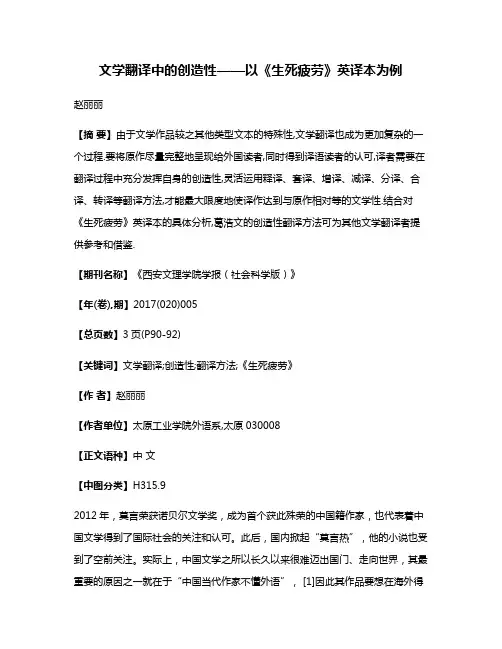
文学翻译中的创造性——以《生死疲劳》英译本为例赵丽丽【摘要】由于文学作品较之其他类型文本的特殊性,文学翻译也成为更加复杂的一个过程.要将原作尽量完整地呈现给外国读者,同时得到译语读者的认可,译者需要在翻译过程中充分发挥自身的创造性,灵活运用释译、套译、增译、减译、分译、合译、转译等翻译方法,才能最大限度地使译作达到与原作相对等的文学性.结合对《生死疲劳》英译本的具体分析,葛浩文的创造性翻译方法可为其他文学翻译者提供参考和借鉴.【期刊名称】《西安文理学院学报(社会科学版)》【年(卷),期】2017(020)005【总页数】3页(P90-92)【关键词】文学翻译;创造性;翻译方法;《生死疲劳》【作者】赵丽丽【作者单位】太原工业学院外语系,太原030008【正文语种】中文【中图分类】H315.92012年,莫言荣获诺贝尔文学奖,成为首个获此殊荣的中国籍作家,也代表着中国文学得到了国际社会的关注和认可。
此后,国内掀起“莫言热”,他的小说也受到了空前关注。
实际上,中国文学之所以长久以来很难迈出国门、走向世界,其最重要的原因之一就在于“中国当代作家不懂外语”, [1]因此其作品要想在海外得以传播,就必须借助于翻译者的工作,这也需要译者具有极高的双语能力和文化素养。
刘江凯曾在《本土性、民族性的世界写作——莫言的海外传播与接受》一文中说道:“中国文学最大的问题是‘翻不出来’……合适的翻译人才太少……,从这点而言,莫言或许是幸运的,因为他的英语译者是号称为中国现代文学首席翻译家的葛浩文先生(Howard Goldblatt)。
”[1]毋庸置疑,莫言在走向诺贝尔文学奖的过程中,葛浩文功不可没,因此对他英译本的研究也对我国文学作品的翻译和海外传播具有积极的意义。
文学翻译之所以更为复杂和艰难,原因在于文学作品语言本身的特殊性。
王宏印教授认为,“文学语言具有多义性、变异性、新颖性等特点,并表现出明显的个性化和民族化特色”, [2]由此,文学翻译是“利用语言的多义性,并遵循一定的文体特点和个人风格进行形象传达的创造活动……它以创作活动为基础和先导,以再创作或创造性叛逆实现翻译文学的本质”。
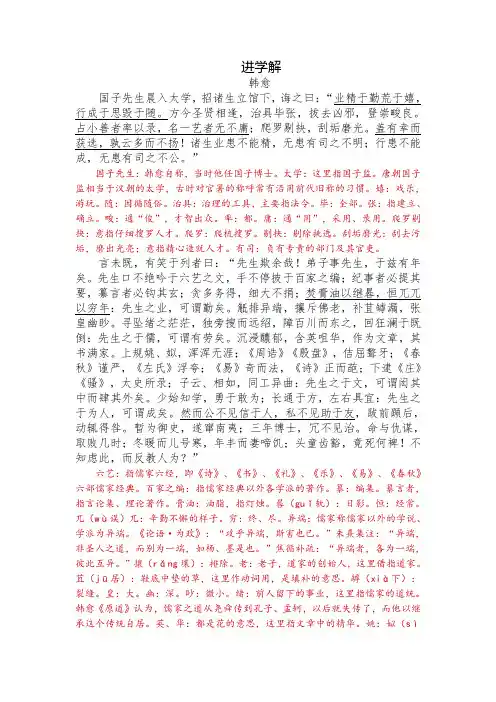
进学解韩愈国子先生晨入太学,招诸生立馆下,诲之曰:“业精于勤荒于嬉,行成于思毁于随。
方今圣贤相逢,治具毕张,拔去凶邪,登崇畯良。
占小善者率以录,名一艺者无不庸;爬罗剔抉,刮垢磨光。
盖有幸而获选,孰云多而不扬!诸生业患不能精,无患有司之不明;行患不能成,无患有司之不公。
”国子先生:韩愈自称,当时他任国子博士。
太学:这里指国子监。
唐朝国子监相当于汉朝的太学,古时对官署的称呼常有沿用前代旧称的习惯。
嬉:戏乐,游玩。
随:因循随俗。
治具:治理的工具,主要指法令。
毕:全部。
张:指建立、确立。
畯:通“俊”,才智出众。
率:都。
庸:通“用”,采用、录用。
爬罗剔抉:意指仔细搜罗人才。
爬罗:爬梳搜罗。
剔抉:剔除挑选。
刮垢磨光:刮去污垢,磨出光亮;意指精心造就人才。
有司:负有专责的部门及其官吏。
言未既,有笑于列者曰:“先生欺余哉!弟子事先生,于兹有年矣。
先生口不绝吟于六艺之文,手不停披于百家之编;纪事者必提其要,纂言者必钩其玄;贪多务得,细大不捐;焚膏油以继晷,恒兀兀以穷年:先生之业,可谓勤矣。
觝排异端,攘斥佛老,补苴罅漏,张皇幽眇。
寻坠绪之茫茫,独旁搜而远绍,障百川而东之,回狂澜于既倒:先生之于儒,可谓有劳矣。
沉浸醲郁,含英咀华,作为文章,其书满家。
上规姚、姒,浑浑无涯;《周诰》《殷盘》,佶屈聱牙;《春秋》谨严,《左氏》浮夸;《易》奇而法,《诗》正而葩;下逮《庄》《骚》,太史所录;子云、相如,同工异曲:先生之于文,可谓闳其中而肆其外矣。
少始知学,勇于敢为;长通于方,左右具宜:先生之于为人,可谓成矣。
然而公不见信于人,私不见助于友,跋前踬后,动辄得咎。
暂为御史,遂窜南夷;三年博士,冗不见治。
命与仇谋,取败几时;冬暖而儿号寒,年丰而妻啼饥;头童齿豁,竟死何裨!不知虑此,而反教人为?”六艺:指儒家六经,即《诗》、《书》、《礼》、《乐》、《易》、《春秋》六部儒家经典。
百家之编:指儒家经典以外各学派的著作。
纂:编集。
纂言者,指言论集、理论著作。
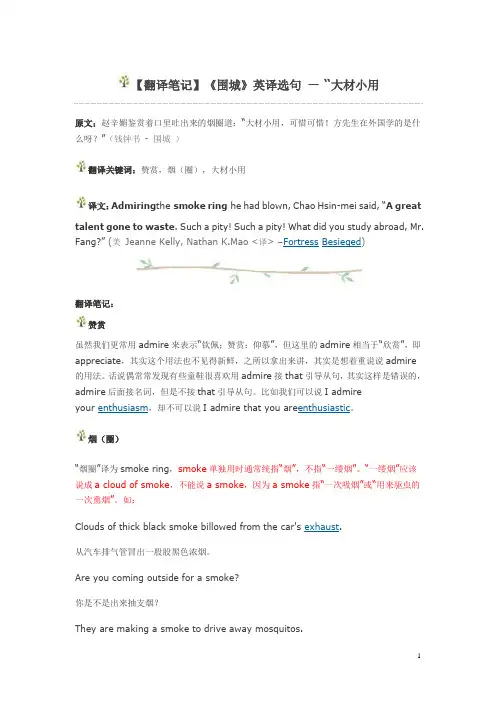
【翻译笔记】《围城》英译选句—“大材小用原文:赵辛媚鉴赏着口里吐出来的烟圈道:―大材小用,可惜可惜!方先生在外国学的是什么呀?‖(钱钟书- 围城)翻译关键词:赞赏,烟(圈),大材小用译文:Admiring the smoke ring he had blown, Chao Hsin-mei said, ―A greattalent gone to waste. Such a pity! Such a pity! What did you study abroad, Mr. Fang?‖(美Jeanne Kelly, Nathan K.Mao <译> –Fortress Besieged)翻译笔记:赞赏虽然我们更常用admire来表示―钦佩;赞赏;仰慕‖,但这里的admire相当于―欣赏‖,即appreciate,其实这个用法也不见得新鲜,之所以拿出来讲,其实是想着重说说admire的用法。
话说偶常常发现有些童鞋很喜欢用admire接that引导从句,其实这样是错误的,admire后面接名词,但是不接that引导从句。
比如我们可以说I admireyour enthusiasm,却不可以说I admire that you are enthusiastic。
烟(圈)―烟圈‖译为smoke ring,smoke单独用时通常统指―烟‖,不指―一缕烟‖。
―一缕烟‖应该说成a cloud of smoke,不能说a smoke,因为a smoke指―一次吸烟‖或―用来驱虫的一次熏烟‖。
如:Clouds of thick black smoke billowed from the car's exhaust.从汽车排气管冒出一股股黑色浓烟。
Are you coming outside for a smoke?你是不是出来抽支烟?They are making a smoke to drive away mosquitos.他们正在用烟把蚊子熏走。
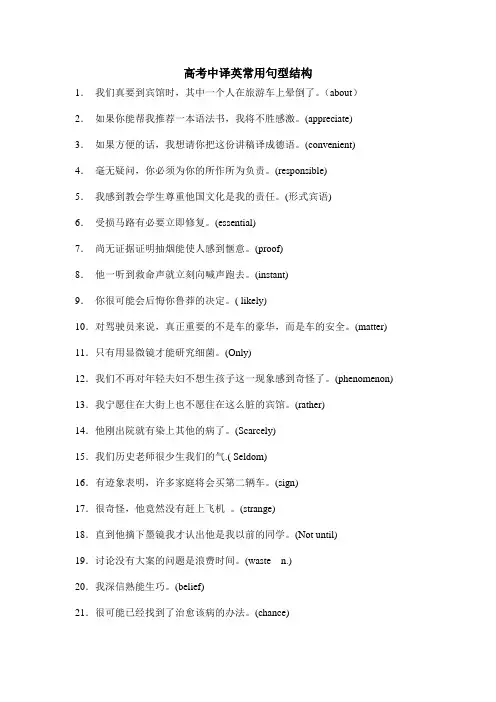
高考中译英常用句型结构1.我们真要到宾馆时,其中一个人在旅游车上晕倒了。
(about)2.如果你能帮我推荐一本语法书,我将不胜感激。
(appreciate)3.如果方便的话,我想请你把这份讲稿译成德语。
(convenient)4.毫无疑问,你必须为你的所作所为负责。
(responsible)5.我感到教会学生尊重他国文化是我的责任。
(形式宾语)6.受损马路有必要立即修复。
(essential)7.尚无证据证明抽烟能使人感到惬意。
(proof)8.他一听到救命声就立刻向喊声跑去。
(instant)9.你很可能会后悔你鲁莽的决定。
( likely)10.对驾驶员来说,真正重要的不是车的豪华,而是车的安全。
(matter) 11.只有用显微镜才能研究细菌。
(Only)12.我们不再对年轻夫妇不想生孩子这一现象感到奇怪了。
(phenomenon) 13.我宁愿住在大街上也不愿住在这么脏的宾馆。
(rather)14.他刚出院就有染上其他的病了。
(Scarcely)15.我们历史老师很少生我们的气.( Seldom)16.有迹象表明,许多家庭将会买第二辆车。
(sign)17.很奇怪,他竟然没有赶上飞机。
(strange)18.直到他摘下墨镜我才认出他是我以前的同学。
(Not until)19.讨论没有大案的问题是浪费时间。
(waste n.)20.我深信熟能生巧。
(belief)21.很可能已经找到了治愈该病的办法。
(chance)22.今天越努力,明天就越不会后悔。
(the more…, the more…)23.我从未像如今这样热爱过中国文学。
(Never)24.我不懂他为何改变主意,也不在乎。
(nor)25.你在其他任何地方也找不到如此齐全的表链收藏。
(Nowhere)26.他从未想过自己是最晚的知噩耗的人.(occur)27.既然没有人支持你,再坚持这个计划就没有意义了。
(point)28.没有收集事实得出结论有何用呢?(point)29.你不可能在一年之内获得所是学位。
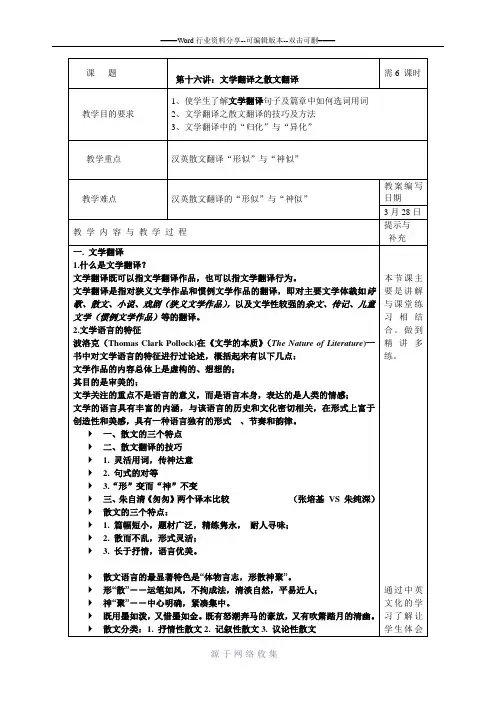
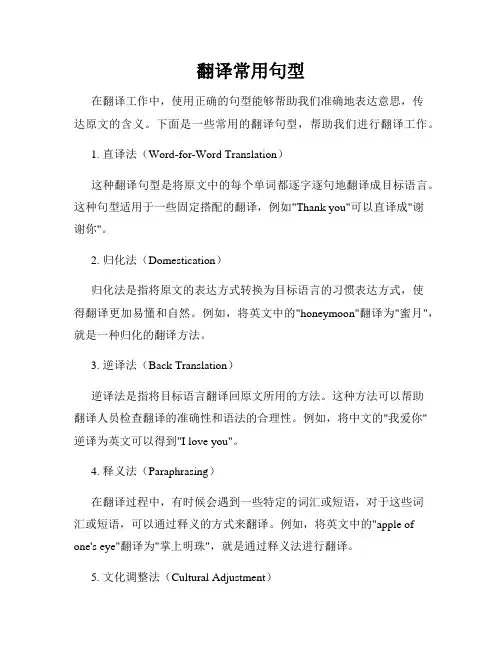
翻译常用句型在翻译工作中,使用正确的句型能够帮助我们准确地表达意思,传达原文的含义。
下面是一些常用的翻译句型,帮助我们进行翻译工作。
1. 直译法(Word-for-Word Translation)这种翻译句型是将原文中的每个单词都逐字逐句地翻译成目标语言。
这种句型适用于一些固定搭配的翻译,例如"Thank you"可以直译成"谢谢你"。
2. 归化法(Domestication)归化法是指将原文的表达方式转换为目标语言的习惯表达方式,使得翻译更加易懂和自然。
例如,将英文中的"honeymoon"翻译为"蜜月",就是一种归化的翻译方法。
3. 逆译法(Back Translation)逆译法是指将目标语言翻译回原文所用的方法。
这种方法可以帮助翻译人员检查翻译的准确性和语法的合理性。
例如,将中文的"我爱你"逆译为英文可以得到"I love you"。
4. 释义法(Paraphrasing)在翻译过程中,有时候会遇到一些特定的词汇或短语,对于这些词汇或短语,可以通过释义的方式来翻译。
例如,将英文中的"apple of one's eye"翻译为"掌上明珠",就是通过释义法进行翻译。
5. 文化调整法(Cultural Adjustment)在进行跨文化翻译时,有时候需要对原文进行文化上的调整,使得翻译更符合目标语言的文化习惯和价值观。
例如,将英文的"black cat"翻译为中文时,可以添加"瑞"或"吉"这样的字眼,因为在中国文化中,黑猫往往象征着好运。
6. 意译法(Free Translation)意译法是指在翻译过程中,将原文的意思进行合理转换,以使得翻译更符合目标语言的语法和表达习惯。
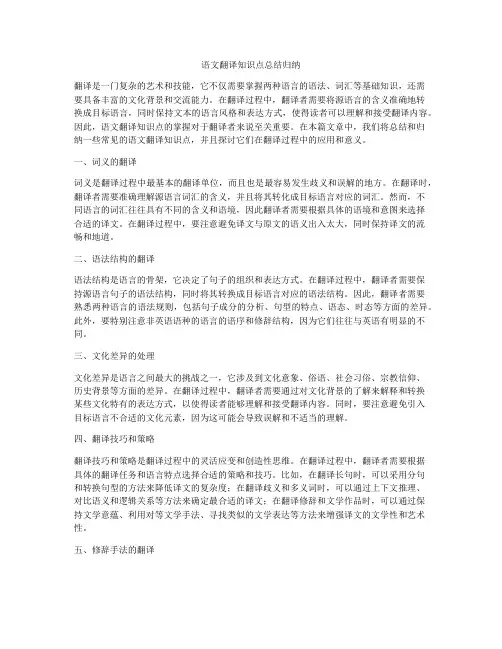
语文翻译知识点总结归纳翻译是一门复杂的艺术和技能,它不仅需要掌握两种语言的语法、词汇等基础知识,还需要具备丰富的文化背景和交流能力。
在翻译过程中,翻译者需要将源语言的含义准确地转换成目标语言,同时保持文本的语言风格和表达方式,使得读者可以理解和接受翻译内容。
因此,语文翻译知识点的掌握对于翻译者来说至关重要。
在本篇文章中,我们将总结和归纳一些常见的语文翻译知识点,并且探讨它们在翻译过程中的应用和意义。
一、词义的翻译词义是翻译过程中最基本的翻译单位,而且也是最容易发生歧义和误解的地方。
在翻译时,翻译者需要准确理解源语言词汇的含义,并且将其转化成目标语言对应的词汇。
然而,不同语言的词汇往往具有不同的含义和语境,因此翻译者需要根据具体的语境和意图来选择合适的译文。
在翻译过程中,要注意避免译文与原文的语义出入太大,同时保持译文的流畅和地道。
二、语法结构的翻译语法结构是语言的骨架,它决定了句子的组织和表达方式。
在翻译过程中,翻译者需要保持源语言句子的语法结构,同时将其转换成目标语言对应的语法结构。
因此,翻译者需要熟悉两种语言的语法规则,包括句子成分的分析、句型的特点、语态、时态等方面的差异。
此外,要特别注意非英语语种的语言的语序和修辞结构,因为它们往往与英语有明显的不同。
三、文化差异的处理文化差异是语言之间最大的挑战之一,它涉及到文化意象、俗语、社会习俗、宗教信仰、历史背景等方面的差异。
在翻译过程中,翻译者需要通过对文化背景的了解来解释和转换某些文化特有的表达方式,以使得读者能够理解和接受翻译内容。
同时,要注意避免引入目标语言不合适的文化元素,因为这可能会导致误解和不适当的理解。
四、翻译技巧和策略翻译技巧和策略是翻译过程中的灵活应变和创造性思维。
在翻译过程中,翻译者需要根据具体的翻译任务和语言特点选择合适的策略和技巧。
比如,在翻译长句时,可以采用分句和转换句型的方法来降低译文的复杂度;在翻译歧义和多义词时,可以通过上下文推理、对比语义和逻辑关系等方法来确定最合适的译文;在翻译修辞和文学作品时,可以通过保持文学意蕴、利用对等文学手法、寻找类似的文学表达等方法来增强译文的文学性和艺术性。
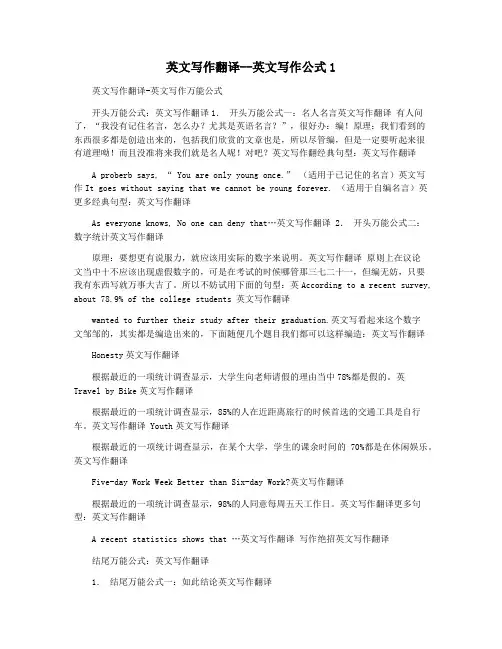
英文写作翻译--英文写作公式1英文写作翻译-英文写作万能公式开头万能公式:英文写作翻译1.开头万能公式一:名人名言英文写作翻译有人问了,“我没有记住名言,怎么办?尤其是英语名言?”,很好办:编!原理:我们看到的东西很多都是创造出来的,包括我们欣赏的文章也是,所以尽管编,但是一定要听起来很有道理呦!而且没准将来我们就是名人呢!对吧?英文写作翻经典句型:英文写作翻译A proberb says, “ You are only young once.” (适用于已记住的名言)英文写作It goes without saying that we cannot be young forever. (适用于自编名言)英更多经典句型:英文写作翻译As everyone knows, No one can deny that…英文写作翻译 2.开头万能公式二:数字统计英文写作翻译原理:要想更有说服力,就应该用实际的数字来说明。
英文写作翻译原则上在议论文当中十不应该出现虚假数字的,可是在考试的时候哪管那三七二十一,但编无妨,只要我有东西写就万事大吉了。
所以不妨试用下面的句型:英According to a recent survey, about 78.9% of the college students 英文写作翻译wanted to further their study after their graduation.英文写看起来这个数字文邹邹的,其实都是编造出来的,下面随便几个题目我们都可以这样编造:英文写作翻译Honesty英文写作翻译根据最近的一项统计调查显示,大学生向老师请假的理由当中78%都是假的。
英Travel by Bike英文写作翻译根据最近的一项统计调查显示,85%的人在近距离旅行的时候首选的交通工具是自行车。
英文写作翻译 Youth英文写作翻译根据最近的一项统计调查显示,在某个大学,学生的课余时间的70%都是在休闲娱乐。

1、Just as Darwin discovered the law of development of organic nature, so Marx discovered the law of development of human history: the simple fact, hitherto concealed by an overgrowth of ideology, that mankind must first of all eat, drink, have shelter and clothing, before it can pursue polities, science, art, religion, etc.; that therefore the production of the immediate material means of subsistence and consequently the degree of economic development attained by a given people or during a given epoch form the foundation upon which the state institutions, the legal conceptions, art, and even the ideas on religion, of the people concerned have been evolved, and in the light of which they must, therefore, be explained, instead of vice versa, as had hitherto been the case.正像达尔文发现有机界的规律一样,马克思发现了人类历史的发展规律,即历来被繁茂芜杂的意识形态所掩盖着的一个简单事实:人们首先必须吃、喝、住、穿,然后才能从事政治、科学、艺术、宗教等活动;所以,直接的物质生活资料的生产和一个民族或一个时代的一定的经济发展程度,便构成为基础,人们的国家制度,法律的概念,艺术以至宗教概念,就是从这个基础上发展起来的,因而,也必须由这个基础来解释,而不像过去那样做得正好相反。
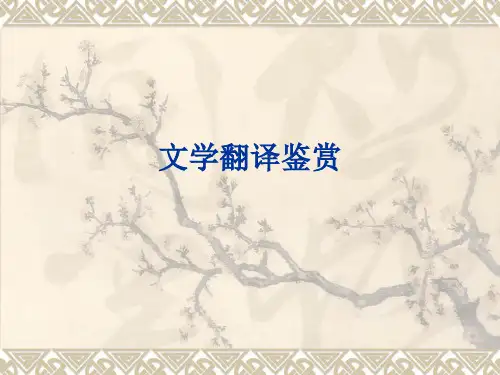
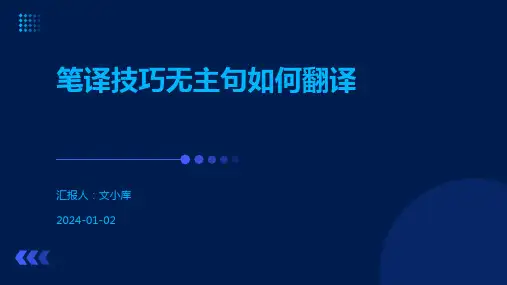
T en lectures on literal translation 文学翻译十讲Liu ZhongdeLecture One Nature of T ranslationT ranslation is a science or an art?Science: this maintains that translating should reproduce the message of the original by means of the transformation of linguistic equivalence. It puts stress on the study of description of the process of translation, and the structures and forms of language so as to reveal the objective laws inherent in translating.Art:the latter school advocates re-creating a literary work by using expressions of another language. It emphasizes the effect of translation.Translation is a science: we say that translation is a science, it has its two laws and methods. Take the translation between English and Chinese for example. If we want to translate well, we must be entirely familiar with the content of the original and all knowledge it concerns. In addition, we should have a comprehensive and thorough study of English and Chinese so that we may do our work with high proficiency.Chinese and English have their respective characteristics. Of course they have similarities, for example, the word order of the subject and its predicate, of the transitive verb and its object and of the preposition and the object it governs. Also they have remarkable differences: for instance, the former has no articles but the latter has the "definite" and the "indefinite" articles. Although they have differences, still we can do the translation between them. It is because language is the direct reality of thought and the basic law of reality--thought----language which reflects the objective existence is in common to both English and Chinese, thus making it possible to express the same ideas and feelings in different languages.And at the same time, we must admit that the languages in which various peoples think and express their thoughts are quite different in characteristics and usage. This is the problem that troubles the translators. If one wants to be a qualified translator, one should, first, have a penetrating study and careful comparison of the similarities and differences between two languages so that one may find the corresponding laws and methods in the translation between them, do translation effectively and ensure the quality of translation.例:the horse is a useful animal 马是一个有用的动物马是一种有用的动物马是有用的动物at first sight, the first translation seems to be very faithful. Every word is translated into Chinese, but in fact it is wrong because it fails to convey the intrinsic sense of original. The second one should be further improved as the third one in order to achieve the conciseness which is characteristic of the Chinese language.The existence or non-existence of articles is a basic difference between English and Chinese as discussed in the above. Also more verbs and fewer nouns and prepositions are used in Chinese than in English while more nouns and prepositions and fewer verbs are used in English than in Chinese.Translation is an art:Q 1: is translation really far easier than creation?A: writing is rather hard. A writer should had rich experience in life and accumulated a great deal of source material. What is more, he should be good at generalization and creation. Only thus, is it possible for him to produce a satisfactory work.A qualified translator must possess the following 3 qualifications: 1) he must be in the two languages concerned and quite familiar with their characteristic, similarities and differences. 2) hemust have a thorough understanding of the content, artistic features and style of the original and the historical background in which it was written. 3) he must know very well the basic principles and methods of translation and is experienced in practice.Y an Fu once said: it often takes as long as ten days or even a whole month to establish a term in translation after repeated consideration and hesitation.The difficulty in translation lies in the fact that the content and the style are already existent in the original and as a result, you will have to do your best to reproduce them as they are in quite a different language.So translation is not only a science with its own laws and methods but also an art of reproduction and re-creation.Lecture two Principles of translation信,达,切---faithfulness, expressiveness and closenessFaithfulness---to be faithful to the content of the originalExpressiveness---to be as expressive as the originalCloseness---to be as close to the original style as possibleOnly after a translator achieves the faithfulness in content and smoothness or expressiveness in wording can be further pursue the closeness in style.Lecture Three literal translation and free translation Literal translation: an adequate representation of the original almost without any change of word-order or sentence structure.Free translation: an alternative approach which is used mainly to convey the meaning and spirit of the original without trying to reproduce its sentence patterns of figures of speech.例证:kill two birds with one stone析:literal translation----一石二鸟Free translation-----一举两得Combination--------一箭双雕例证:你不要班门弄斧了析:literal translation-- don't display your axe at Lu Ban's door .........for Chinese readers Free translation----don't teach you grandmother to suck eggs.......For foreign readersFree translation----never offer to each a fish to swim.Lecture Five Commonly-used methods of translation1) corresponding sentence patters 句型对应例证:as soon as he come to Changsha, he paid a visit to Y uelu Academy译:他一到长沙,就访问了岳麓书院例证:你书读的越多,你就会越有学问译:the more you read, the more learned you will become2) rearrangement of word order 次序调整例证:when he was twelve, Mark Twain lost his father 译:马克吐温十二岁时失去了父亲3)conversion of part of speech 词类转化例证:he dialed the wrong number 译:他拨错了电话号码4)proper addition or omission例证:we don't retreat, we never have and never will译:我们不后退,我们不曾后悔,我们也永远不会后退例证:Bob got up very early in the morning 译:早上Bob起的很早。
高考句型翻译120句(keys)高考句型翻译120句(2015. 9)一、强调句1.正是这首歌让我回忆起我们共度的时光。
(It…)It was the song that reminded me of the time we had spent together.2.是你的努力而不是才智决定你的成功。
(determine)It is your effort(s) not your intelligence that determine your success.3.正是在20世纪60年代,袁隆平第一次想到了杂交水稻这个概念。
( It)It was in the 1960s that Yuan Longping came up with the idea of hybrid rice for the first time.4.直到将近一个月后我才收到那家公司的回复。
(It is…that)It was not until nearly a month later that I received that company’s reply.5.直到救出了第三个学生后,那个老师才意识到自己的女儿还被困在废墟中。
(It)It is not until he rescued the third student that he realized his daughter was trapped in the ruin二、倒装句1.直到他被复旦大学录取后才告诉我这个消息。
(not until三种句型)He didn’t tell me the n ews until he was admitted to Fudan University.Not until he was admitted to Fudan University did he tell me the news.It was not until he was admitted to Fudan University that he told me the news.2.只有当我们完全理解生命的价值时我们才会珍惜幸福的每一刻并且帮助周围的人。
英语多被动,汉语多主动英语多代词,汉语多实称英语多省略,汉语多补充英语表达多变化,汉语表达多重复英语多长句、从句,汉语多短句、分句文学翻译与应用翻译不同,前者重在“达和雅”,讲文学修辞,重在文学的再创作上;而后者重在“信和达”,讲结构,重在两种语言的结构转换上。
所以结构上了解“汉语与英语两种语言思维表达上的特点与差异”对应用文的汉译英是十分重要的。
中国人擅长客观思维,思维表达的方式总是遵循时间和事理发展的先后顺序,由因到果,由先到后,由大到小,由外到内,按发展的层次顺序进行阐述;如:(1)海南翻译公司地址:‘中国海南省海口市龙昆北路38号华银大厦2305室’,这句是最典型的从大到小的表达形式。
(2)我每天早上在室外高声朗读英文。
主语+ 时间状语 + 地点 + 方式 + 谓语 + 宾语。
(3)蜂胶是蜜蜂采集植物伤口的粘性保护物质(树脂)与蜜蜂提内分泌物加工而成的。
(4)不到三亚,枉来海南。
而西方人擅长抽象思维,表达事物总是先概括后分解,先表态后叙述,先总结后事例,先整体后细节,先点出主题后进行论证,由结果到原因、由小到大等。
西方人的思维与中国人的正好相反。
译文:(1) Rm2305, Huayin Building, 38 Longkun N.Rd, Haikou City, Hainan, China(2) I read English loudly in the open every morning.主语+谓语+宾语 + 方式状语 +地点状语 + 时间状语(3) Bee glue is prepared with the resinous substance(resin)on plant wound for protection gatheredby bees and the bee’s inscretion.(4) A visit to Hainan would not be completed without visiting Sanya. 这几句英语的译文,主语和谓语的位置与中文的明显的不同,状语顺序正好颠倒了。
四种翻译与方法十种翻译技巧
四种中文翻译方法:
1.直译法:将源语言的文字直接翻译成目标语言,尽量保持原文的语义和结构。
这种方法适用于简单明了的语句和翻译需求。
2.意译法:根据源语言的意思,使用目标语言更直观、更自然的表达方式进行翻译。
这种方法适用于一些表达形式、文化背景不同的语句。
3.逐句翻译法:逐句对源语言进行翻译,保持原文的句子结构和词语顺序不变。
这种方法适用于要求准确传达每个句子的语义的场合。
4.自由翻译法:根据源语言的意思,使用目标语言更自由、灵活的表达方式进行翻译。
这种方法适用于文学作品等需要加入翻译者个人风格和创意的翻译。
十种中文翻译技巧:
1.熟悉源语言和目标语言的语言和文化特点。
2.理解源文的含义和意图,尽量准确传达。
3.注意上下文的语境,避免歧义和错误理解。
4.学会使用同义词和近义词进行替换,使翻译更准确、简洁。
5.注意文体和语气的转换,保持翻译的自然流畅。
6.尽量保持原文的结构和句型,避免翻译成目标语言的错误句法。
7.注意音译和意译的选择,根据需求和准确传达的需要进行选择。
8.学会使用翻译工具和辅助资源,提高翻译效率和准确度。
9.多进行反复校对和修改,确保翻译的准确性和流畅性。
10.继续学习和提升语言能力,积累更多的翻译经验和知识。
1.It is sometimes beset with … 有时候会有…的境遇/会有…相伴2.Nothing short of a … can help … 唯有…才能/全靠…才能够3.Rolling on non-stop for thousands upon thousands of miles. 一泻千里4.Fare likewise. 正如这样manure vat 便桶5.Now … , now … 有时…,有时…6.Better able to generate in oneself a sensation of … 更能让人产生一种…之感7.… is now confronted with a … section of its course. …现在正遭遇进程上的一段…8.… , however, can only be shared by … 而…,只有…样的人才可体会到9.The presen t … crisis can never obstacle the advance of … 目前的…危机绝不会阻碍…的进步10.Let us brace up our spirits and march through … 让我们鼓起雄健的精神…11.The greatest joy of …, is to … during its most difficult days. 在最艰难的日子里…,亦是最大的乐趣12.Grow restless 变得焦躁不安Beg to differ 恕不同意/持反对意见13.Dash here and there in search of … 跑来跑去的寻找14.He is going to … so that he could … 他决定…以便…15.… is not groundless because … …并非空害怕/没依据,因为…16.Keep moving around in a hurry 慌慌张张地走/跑17.What’s the rush? 为何这般慌?/怎么这么着急?18.Behind … lay half a dozen of … near … 注意学习地理方位和位置的表述19.look like rain, yet, to our great joy … [口语]像是要下雨,然而让我们高兴的是…20.which of you could … 你们谁能……?(别用who了,太土了!!)21.they are most beloved in one aspect. 有一点最受人爱/有一点最为可贵22.Unlike … , which … , … it just … to … 不像…的…一样,它只是…,来…23.You can never immediately tell whether or not it … until …你不能立刻判断它是否…,非得等到…24.One should be useful rather than great or nice-looking. 应该成为有用的人,而不是伟大或体面的人25.Engraved in my mind. 深深地刻在脑海26.… is a household name all over the country. ……是家喻户晓/名遍全国的。
27.… is always on the lips because … 把…天天挂在嘴上,因为…28.What’s the use of being … ……又有什么用/有什么必要呢?29.Uttered intermittently. 断断续续地说30.Never calculating or particular about personal gains and losses. 不计较个人得失31.Honor … with a posthumous reverent … 追授…一个…的谥号/称号32.Become more and more … with the passing of time. 随着时间的流逝变得越来越……/越久越……33.Never give up the pursuit of … 不要放弃… / 不要放弃对…的追求34.Out of sheer necessity. 仅仅为了需要/ 纯粹因为需要35.Be free to follow your own bent. 可以依自己的喜好去… / 自由自在地去追求自己的喜好36.Be in the prime of life. 正当盛年/ 年富力强37.… will soon be gone never to return. 一去不复返。
38.Be in one’s declining years.风烛残年/ 精力衰微之时39.As a means of subsistence. 作为生计/ 为了吃饭/ 作为谋生的手段40.Remedy the situation by … 用……来补救e up against the urgent problem of … ……问题急需解决42.How can one manage to … while … 人怎么能在…的同时还…呢?43.Cut down on food and clothing and do everything possible to … 节衣缩食想尽办法去……44.Time is no object. 时间不是问题。
45.… will be quite enough to make … a ……足够让一个…成为…了46.The choice lies with you. 选择权在你们手里。
47.Henrik Ibsen says, “it is your supreme duty to cast yourself into a useful implement.”你最大的责任是把你这块材料铸造成器。
48.Forsake … , and you will ruin yourself. 抛弃…,你便毁了你自己。
49.To go into scholarship, to engage in learning. 做学问50.the only things of some value under my roof, if any, are …在我屋子里唯一贵重的东西就是…51.Entertain ambition of making a profound study of … 怀有对……做一番高深研究的野心52.It seemed that … can better satisfy … than … …比…更能满足…的需要53.At one sitting. 一口气地…54.It is completely subjected to the whims of the moment. 全凭当时的兴趣和念头。
55.Liken myself respectively to … 把我自己比作……56.Thread-bound Chinese book. 线装书57.My obsession of … have been very much on a decline.我对……的狂热/着迷消除了不少。
58.To eat into one’s whole pocket. 花掉某人所有的钱。
59.But not all acquaintances are friends. 不是所有认识的都是朋友。
60.Have more scruples about this and that. 对身边的一切都有更多的顾虑。
61.We each followed a different course of life. 我们各自过着不同的生活。
62.Be bound to. 必然,一定会。
Somehow or other. 设法,莫名其妙地63.… of bygone days will unfold again before one’s eyes. 过去的…又重新浮现在某人眼前。
64.In bloom of one’s youth. 在某人盛年的时候/ 在生命中最华美的时刻65.Unwittingly 不知不觉地,无意识地66.Fritter away. 渐渐地消失/ 慢慢地消耗/ 一点点地浪费67.In twos and threes. 三三两两,零零星星68.Negotiate shoals and reefs / deserts and gorges 跋涉(越过)礁石浅滩/ 荒漠峡谷69.Be reduced to … as the last resort. 被逼到做……的地步,被迫干……为生70.Foot passenger. 步行的人,行人71.It stands to reason / can hold water that … …也是合情合理的/显而易见的72.Can ill afford to do something. 无法承受……73.If it is beyond one’s capacity to single-handedly stem the prevailing of social evils, one should at leastbe self-disciplined so as not to make matters worse.74.Pedantic view of bookish person. 酸腐的书生之见75.Cool your heels。
坐冷板凳,空等76.All that kills my idea of … 那足以让我打消……的念头77.A good man always enjoys Heaven’s protection. 吉人天相/all’s well that ends well78.Misfortune never comes singly 祸不单行79.Heaven will always leave a door open / There is always a way out. 天无绝人之路80.Be in reduced circumstance. 每况愈下/ 光景惨淡81.After some wavering, 犹豫一阵之后/ 犹豫不决了一阵82.Talk somebody out of it(something), 劝说某人不做某事83.Smart aleck 自作聪明的人/ 自作聪明的84.Chip in 插嘴,打断,捐助,出钱stroll about 游逛,游荡,闲游85.Be watchful on the way, 路上警惕些,旅途当心86.It is certainly no problem for a person of my age to …对于我这样年纪/ 我这么大的人来说,……是没问题的87.A strenuous job: 紧张的/费力的/艰苦的差使88.Skullcap 无沿小帽,圆帽Mandarin jacket 马褂cotton-padded 填充棉絮的89.Huddle up 蜷缩,挤成一团Corpulent 肥胖的90.Gush from涌出,不断流出trickle 滴,淌,细流ooze 渗出,淌出91.Make an enormous exertion to … 尽全力做……92.Pat the dirt off one’s clothes 拍去/掸去身上的尘土93.until his figure was lost among crowds of people hurrying to and fro and no longer visible. 直到他的身影消失在来往的人群中,再也遍寻不见了。